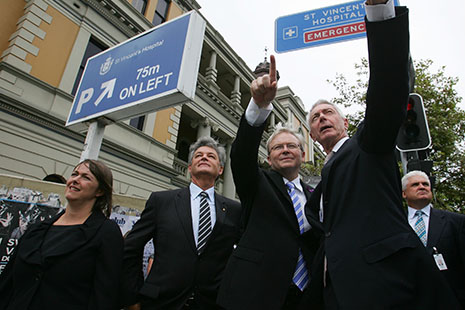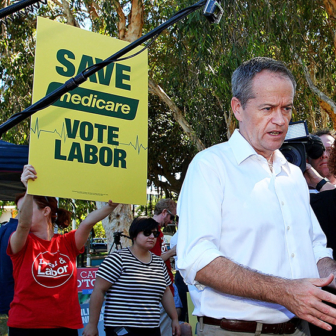ELECTED with sweeping promises to fix the ailing health system, Kevin Rudd has now announced plans for a National Health and Hospitals Network, the first instalment of major structural change. While short on detail, the prime minister’s National Health Reform Plan focuses on the funding and governance of public hospitals. It proposes a sweeping increase in Commonwealth financial responsibilities – but far short of a complete takeover. It calls for a fundamental change in the way most hospitals are paid, increased scrutiny of the quality of the services they deliver, and a radical decentralisation of management and accountability. The Commonwealth currently funds most primary care through Medicare; under the plan it would assume financial responsibility for other primary care services such as hospital outpatient clinics and community nursing. These transfers of some state funding responsibilities would require a claw-back of a third of the GST revenues currently guaranteed to the states.
The outcome of the deliberations of the National Health and Hospitals Reform Commission and the hundred-odd public consultations that followed, the plan makes large claims about setting in train a revolution in health care management, declaring that it will end “blame games,” set hospital finances on a sustainable footing and relax the centralism that has undermined accountability, morale and some of the public trust in public hospitals.
Few of its measures are bolts from the blue. As John Howard’s minister for health, Tony Abbott argued for a national takeover of the hospital system, declaring that “the only big reform worth considering is giving one level of government – inevitably the federal government – responsibility for the entire health system.” In 2009 the state and territory governments, meeting as the Council of Australian Governments, or COAG, signed a National Health Partnership Agreement, including a “move to a proper long-term share of Commonwealth funding for the public hospital system.” The “proper” level was left unstated, but was unlikely to involve a reduction.
The first instalment of a wider reform agenda, this week’s announcement is also the opening shot in the Rudd government’s campaign for a second term. It is just one – though the largest – piece in a complex jigsaw puzzle. We need to see the other pieces, but for the moment, it should be read as a political text: an opening set of negotiating positions with the states and territories and an attempt to establish the field of battle for the federal election, not the finished blueprint of a renovated health system.
Three major themes run through the proposals – a new federal–state relationship in hospitals, more efficient and accountable funding systems and a move to more localised systems of governance.
Federalism and hospitals
The plan would give the Commonwealth government a decisive role in hospital finance. Canberra would take on 60 per cent of both recurrent and capital hospital expenditures – in contrast to the current level of 40 per cent of recurrent expenditure and no responsibility for capital expenditure. Part of this would be funded by clawing back GST revenue, a proposition that adds to the administrative and political difficulties of the plan.
Australia’s federal system is marked by a large mismatch – a “vertical fiscal imbalance” – between the revenues each level of government attracts, and their respective responsibilities. When the federal government assumed control of income taxation in 1942, the states lost access to all major revenue sources. The GST itself is technically a Commonwealth tax: the guarantee that all GST revenues will go to the states is contained in federal legislation and could be reversed by legislative amendment.
The costs of state delivery of services, including health, have risen rapidly, creating a mismatch of financial resources and responsibilities. The consequences of this fiscal imbalance work out in the health system: the states became increasingly dependent on funds transferred from the Commonwealth; in turn, this leads to confused lines of responsibility. Is the ultimate, though indirect, funder responsible for the state of the hospitals, or the level of government that administers the services?
The Rudd reforms are designed to sort out this mess. But as the states will still have to find 40 per cent of funding, they are likely to aggravate the confusion. The states will still own and plan new hospitals. Will Canberra meekly hand over its 60 per cent if a state can find its 40 per cent contribution? Sidney Sax, one of the most astute architects and analysts of Australian public health policy, noted long ago that governments “design administrative arrangements that ensure widespread awareness of their fairy godmother role.” It is unlikely the building of new hospitals will prove to be an exception.
Finally, hospital finance seems an odd place to start fundamental health reform. The National Health and Hospitals Network plan starts by warning us that the real problems faced by the health system lie in the management of chronic illness in an ageing society – the challenge of linking preventive and primary care to enable more management of illness in the community, not in the hospitals. But it has little to say about these issues.
“Health” policies too often turn into proposals for improving hospital finances, and in this case there is another glaring anomaly – the public–private mix. Most political attention is focused on the relatively minor question of private health insurance subsidies. Much bigger questions are raised by the drift of medical practice in many specialised areas to the private sector. More accountable and efficient public hospitals will continue to see their waiting lists for elective procedures grow as specialists opt for the comforts of the private sector.
We have been promised further instalments of the reform plan to answer these questions. Politics and the 40 per cent of government health expenditures that go on hospitals dictate that any fundamental health reform must give serious attention to hospital management, efficiency and outcomes. For the moment we must wait for the further pieces of the jigsaw.
Pricing for efficiency
The second major change would be towards funding hospitals on the basis of the “efficient price” of their services. This was a key recommendation of the National Health and Hospitals Reform Commission and builds on moves that were already in train. The COAG National Health Partnership Agreement, signed in 2009, set a five-year target for establishing a nationally consistent system of activity-based funding.
Although the plan carefully avoids the term, this proposal is close to “case mix,” the system brought in by the Kennett government in Victoria to increase transparency of hospital costs. Case mix is often seen as one part of Victoria’s apparent superiority. Any move to make costs more transparent is welcomed but there are considerable technical problems in calculating efficient prices – not least how small regional hospitals would cope. An independent pricing agency would set these “efficient prices,” but with no details of its workings or the involvement or agreement of the states.
Local control
The most striking feature of the Rudd plan would be a shift of management to local hospital networks. Based on referral patterns – the regular connections doctors and smaller hospitals and clinics establish with larger public hospitals – this would establish units based on the way health professionals already interact and could return some control to local communities and health professionals.
One paradox of Australian federalism is that states – often defended as “closer to the people” – have been remorseless centralisers within their own territories. As state governments gradually supplanted charities and churches as the direct funders of public hospitals, administrative control moved from local boards to departments of health or, at most, large area health services, with a lot of interstate variation. The displacement of local control made possible a better alignment of health needs and resources. Maternity and children’s hospital services were moved out of the old inner cities to the newer areas of growth. The existing hospital boards often resisted these reforms and are increasingly seen as sclerotic, marked by political cronyism or dominated by conservative senior clinicians hostile to any change. In the hands of reformers such as Laurie Brereton in New South Wales, abolition of boards was a necessary part of modernisation.
This drive towards centralisation intensified the alienation of many working in hospitals, who felt disenfranchised by a system marked by administrative instability – constant reorganisation for the sake of it – and driven by faceless bureaucrats ignorant of the real problems of those dealing with overcrowded wards. Centralisation also blurred lines of accountability. An ideal of the early British National Health Service was the belief that the sound of a bedpan dropped in Cardiff should resound through the halls of Westminster. A key problem, particularly in New South Wales and Queensland, is that central micromanagement means every problem, however technical or best managed at a local level, moves straight to the minister’s office, intensifying the politicisation of the health system. In Rudd’s proposals, by contrast, the clatter of the bedpan would not escape from Port Macquarie.
This is where we need the most details. How will networks connect with existing regional organisations that deal with population health issues, such as immunisation and health promotion, unsuited to the smaller networks? The National Health and Hospitals Reform Commission recommended that primary care should be organised in areas much larger than those used at present by the divisions of general practice – and far larger than the proposed hospital networks. Will the government proceed with these mooted Primary Health Care Organisations? If hospitals are to connect better with primary care, how would such different organisational structures – one designed on patterns of medical practice, the other on characteristics of population health – interact? Finally, networks would remain state statutory bodies, appointed and so responsible to the states and territories – though (we must presume) with heavy marching orders from the Commonwealth.
Blame games?
Will this end the buck-passing between levels of government? This was one of Rudd’s key themes in the 2007 election – a useful response to Howard’s remorseless blaming of the (Labor controlled) states and territories for every failure in public policy. In fact, this is one of the least likely outcomes. Despite the talk of Commonwealth control, the states remain deeply embedded in health system finances, with plenty of “skin in the game,” in Rudd’s schoolyard phrase, but even fewer resources.
Health is so complicated by conflicting values and powerful interest groups that a neat, comprehensive plan would be certain to fail. Rudd’s plan is best seen as an opening shot in an extended war of position. Its vagueness on detail may be an asset in the long process of bargaining with the states and territories, which have already started the usual street theatre of Australian fiscal federalism. It also sets the scene for a federal election in which health (or hospitals) is the central issue, and where the government has staked out the issues of decentralisation, Commonwealth finance and a shift to greater efficiency, while retaining considerable ground for manoeuvre.
Realising such a complicated set of reforms will require more than another term of office and will require stores of resolve not yet revealed by this government. Medicare – a far simpler proposition – took fifteen years to implement. •




